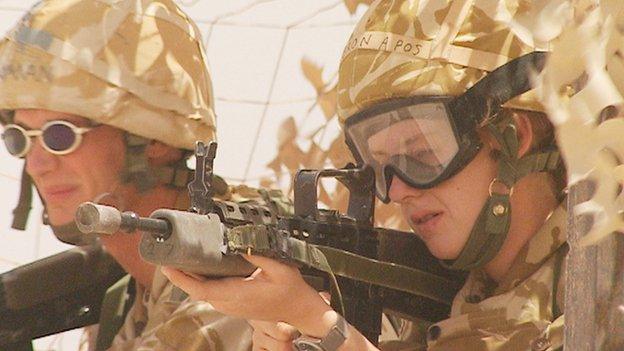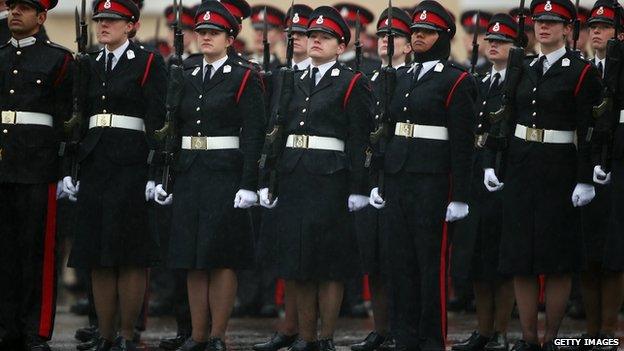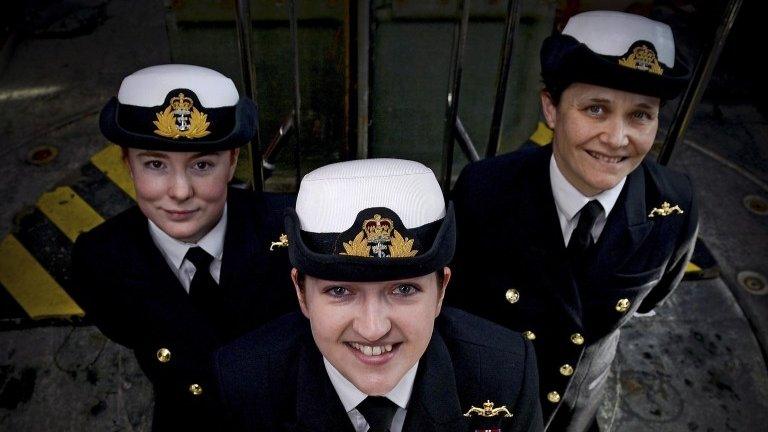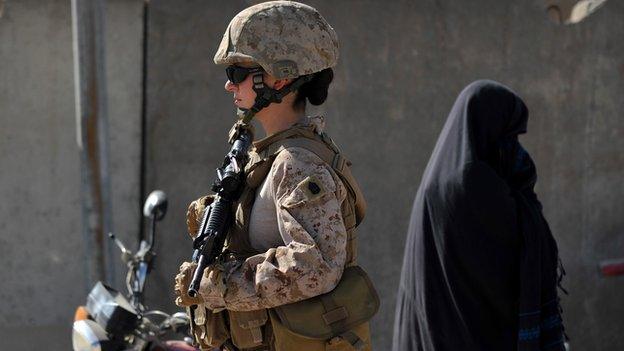Army to review female close combat roles
- Published

The last review of women in combat roles was carried out in 2010
Women soldiers could soon be allowed to serve in front line combat roles in the Army after a review due to take place in 2018 was brought forward.
Currently women can serve on the front line, but not where the primary aim is to "close with and kill the enemy".
Defence Secretary Philip Hammond said head of the Army Sir Peter Wall would report back by the end of the year.
Mr Hammond said he wanted to send a signal that the military is open "to all who can meet the... standards."
Currently women are not permitted to serve in the infantry or armoured corps where they could be involved in close combat.
Mr Hammond said the armed forces still had a "macho image", the "last bastion of male chauvinism. The reality is very different".
Newsnight's Kirsty Wark is joined by two former high-ranking female officers to debate the role of women in the British Army
"I think that at a time when the Americans, the Australians, the Canadians, even the French - the Israelis of course for years - have women in their combat arms, this is something we have to look at again," he said.
He said there would be no "compromise" on fitness requirements, highlighting the fact that engineers searching for explosive devices in Afghanistan had to carry loads of 63kg (10 stone) in a combat zones.
BBC defence correspondent, Jonathan Beale, said government sources had stressed it was not a change of policy.
The Ministry of Defence is required under European law to review its policy every eight years.
Female Olympians
Major Judith Webb, who retired from the Army in 1986, is opposed to women being allowed to take close combat roles.
"We have to accept that we are different physiologically," she said.
"We don't have the same upper-body strength."
Maj Webb said it was "nonsense" to suggest there could be less-demanding tests for women entering combat roles, and reducing standards "across the board" would reduce the effectiveness of the Army.
She said the "occasional woman" might meet standards for male soldiers, but said that would lead to calls for more women to follow - which could result in standards being lowered to promote equality.
Women had proved themselves in a variety of roles and there should be more women in senior ranks, she added.
British regular forces
All services
160,650
-
Includes 15,920 women
-
Navy
3,000 (9%)
-
Army
8,010 (9%)
-
Royal Air Force
4,910 (14%)
Women by service
Brigadier Nicky Moffat, the highest-ranking woman in the British army until her retirement in 2012, said the arguments against women in combat roles were the "same that used to be trotted out to exclude women from the wider range of roles in which they are now allowed to serve".
"There would be of course fewer women than men that will want to join and that will be able to meet the necessarily demanding physical standards, that mustn't be lowered," she said.
Lord Dannatt told the BBC that women should not be in "the combat arms" as "a matter of principle"
She said a 2010 review, external - and the example of the UK's female Olympians - showed there were women with the necessary "psychological and physical" strengths for combat roles.
Labour MP Gisela Stuart, a member of the Defence Select Committee, said: "Increasingly, we are accepting that certain jobs require certain abilities and physical aptitude, and if you meet those requirements you should be able to do the job whether you are a man or a woman."
General Sir Peter Wall, Chief of the General Staff, said it was "now sensible" to review the Army's position on women in combat roles.
But his predecessor as head of the Army, Lord Dannatt, said keeping women out of combat roles was a "point of principle".
Gisela Stuart MP: "Women who want to work in combat roles should be able to if they have the ability and physical aptitude"
"To be in a unit that is given orders to attack a hill, to attack a town, to attack a village, that is a role not for women," he said.
There are almost 16,000 women serving in the combined services, 9.9% of all personnel, according to the latest statistics, external.
The Army has more than 8,000 serving women, 8.7% of the total force, with almost 12% of officer ranks filled by female personnel.
By comparison, women make up 9% of the Royal Navy and 13.8% of the Royal Air Force.

Women now make up almost 9% of the Army, the latest MoD figures show
The 2010 review of women in the Army raised concerns that having men and women in small units for months at a time could undermine "team cohesion".
Changes to the armed forces, also in 2010, meant women were able to take on the role as clearance divers, while in December 2011, it was announced that women would be able to serve on submarines.
Last week, three women became the first female submariners in the 110-year history of the Submarine Service.
The latest review has been welcomed by Labour's shadow defence secretary, Vernon Coaker, who said the armed forces "should give the same opportunities to women as it does to men and this move will hopefully ensure that becomes the case".
- Published8 May 2014
- Published5 May 2014

- Published6 April 2014

- Published29 November 2010